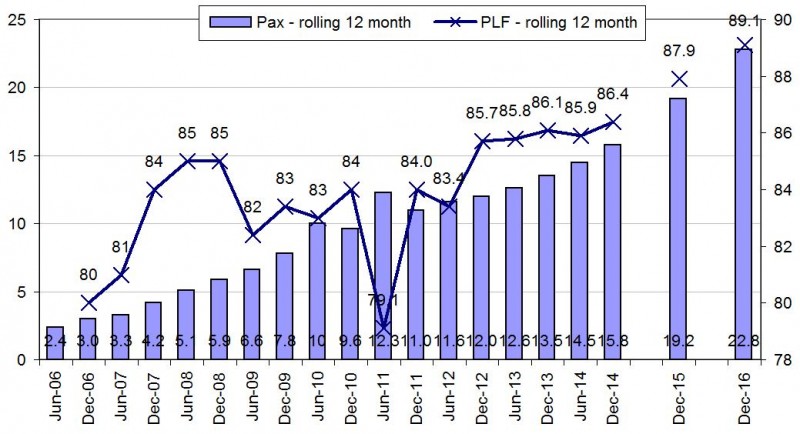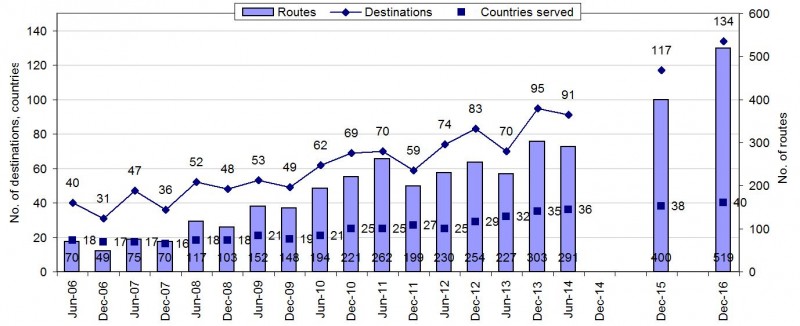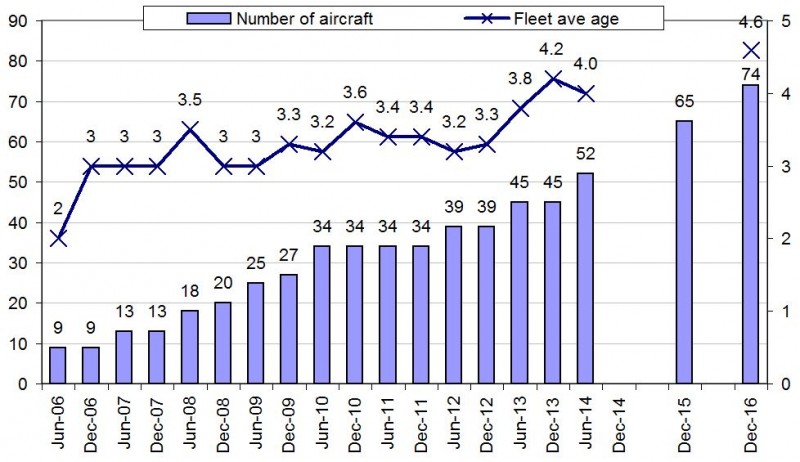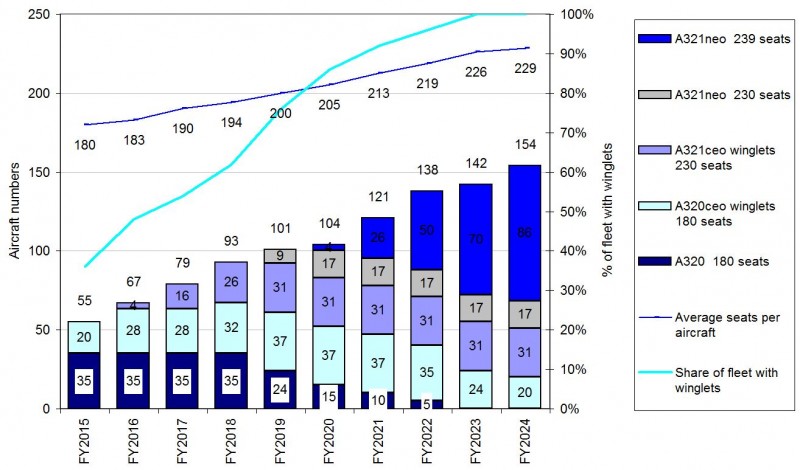Wizz Air: fastest growing top 20 European airline group keeps Ryanair at bay on E/C Europe-W Europe
Wizz Air's 2016 growth was the fastest among all of Europe's top 20 airline groups. Its passenger numbers increased by 19% to almost 23 million in calendar 2016, giving it an average growth rate of 22% pa over the past decade.
Although it is only Europe's 13th largest airline group overall and the number four LCC, Wizz Air is the biggest airline on routes between Eastern/Central Europe and Western Europe. Almost all of its routes are in this core market, and Wizz Air has managed to hold on to its number one spot in the face of strong competition from Ryanair, which is also growing rapidly in this market.
Wizz Air's fleet plan to 2024 is aimed at maintaining double digit growth rates, while also lowering unit costs by adding A321s and A321neos to its A320 equipment. Ten years ago Wizz Air carried only three million passengers, but it will almost certainly break into Europe's top 20 in 2017.
Wizz Air's passenger total increased 19% to 22.8 million in 2016
In the 12 months to Dec-2016 Wizz Air carried 22.8 million passengers, an increase of 18.8% year-on-year. It has achieved a compound average growth rate of 22% pa from 2006 to 2016.
Wizz Air's passenger load factor gained 1.2ppts to reach 89.1% in calendar 2016 - its highest ever level and around 9ppts higher than 10 years earlier. This confirmed its breakout from the mid 80% range that it had occupied for some years until 2014. Nevertheless, it was still below the 90% plus load factors achieved by Europe's two largest - LCCs Ryanair and easyJet.
Wizz Air rolling 12 month passenger numbers (million, left hand axis) and load factor (%, right hand axis): 2006 to 2016
Fastest passenger growth among top 20 European airline groups in 2016
Wizz Air's growth rate of 18.8% was the fastest among Europe's top 20 airline groups by passenger numbers in 2016. The ultra LCC ranked 13th in this list, just behind Pegasus Airlines and Alitalia. Wizz Air's growth rate significantly outpaced that of these two airline groups.
With number 10 ranked Air Berlin Group suffering a fall in passenger numbers and undergoing a restructuring that will halve the size of its core airline, Wizz Air has a good chance of entering the top 10 in 2017.
Number of routes operated by Wizz Air increased 11 times from 2006 to 2016
According to a Wizz Air press release of 5-Jan-2017, it operated to 134 destinations in 40 countries and had 519 routes on sale in 2016.
Data reported to the European Low Fares Airlines Association for 2006 indicate that the number of destinations increased more than fourfold, the number of countries more than doubled, and the number of routes grew almost 11 times compared with 10 years earlier.
Wizz Air: number of destinations, countries served (left hand axis) and routes (right hand axis), 2006 to 2016
89% of Wizz Air routes are between E/C Europe and W Europe
Wizz Air's regional focus is Eastern/Central Europe, where all of its routes either begin or end.
Data from OAG for the week of 16-Jan-2016 indicate that the vast majority of Wizz Air's routes - 89% - are between Eastern/Central Europe and Western Europe, while just 7% are within Eastern/Central Europe. The balance of 4% are from Eastern/Central Europe to the Middle East.
Wizz Air: number of routes by route region, week of 16-Jan-2016
Wizz Air is the leading airline between E/C Europe and W Europe, just ahead of Ryanair
On routes between Eastern/Central Europe and Western Europe Wizz Air is the leading airline by seat capacity. It has 15.4% of seats in this route corridor, compared with Ryanair's 14.9% (source: OAG, week of 16-Jan-2016).
Both ultra LCCs have grown rapidly on these routes in recent years, each increasing their weekly seat capacity by three quarters since mid Jan-2014, when Wizz Air's seat share on routes between Eastern/Central Europe and Western Europe was 10.6% and Ryanair's was 10.2%.
Wizz Air has grown more rapidly than Ryanair in the summer schedule over this period. According to OAG, it will have increased its weekly seat numbers by 82% from the last week of Jun-2014 to the last week of Jun-2017, compared with a 52% increase by Ryanair over the same period.
Wizz Air's seat share for this June week will have increased from 8.4% in 2014 to 12.2% in 2017, overtaking Ryanair, whose share will have risen from 9.0% to 10.8%.
Eastern/Central Europe to Western Europe (seats per week, one way): 13-Jan-2014 to 26-Jun-2017
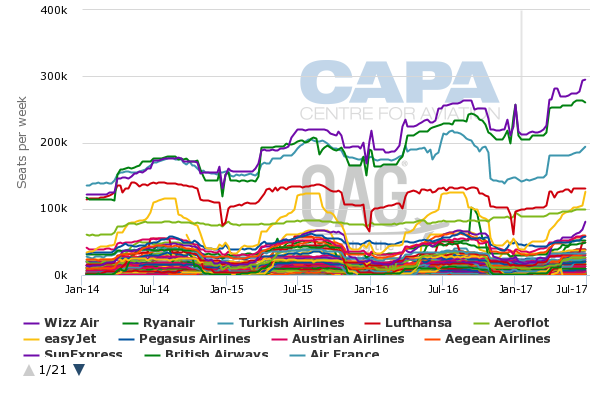
Fleet numbers have almost doubled since Dec-2012
The size of Wizz Air's fleet increased from nine aircraft at the end of 2006 to 74 at the end of 2016 - an increase of more than eight times. The fleet has almost doubled the number of aircraft since Dec-2012, when it comprised 39 aircraft.
Ten years ago the fleet was all A320s, whereas it now includes 11 A321s among the total of 74. Wizz Air took delivery of its first four of the larger type in FY2016.
Wizz Air: number of aircraft (left hand axis) and average fleet age (years, right hand axis), 2006 to 2016
Wizz Air's average fleet age has crept up, but it still less than 5 years
The average age of Wizz Air's fleet is currently 4.6 years (source: CAPA Fleet Database, 16-Jan-2016). This has crept up slightly from an average of 3.0 years at the end of 2006, but compares favourably with most of Europe's leading independent LCCs.
According to the CAPA Fleet Database, Ryanair has an average fleet age of 7.1 years, easyJet 6.8 years and Pegasus 5.2 years. Only Norwegian has a younger fleet than Wizz Air's, with an average of 3.8 years for the Norwegian Group (3.9 years for its narrowbodies).
Europe's leading independent LCCs: average fleet age comparison*
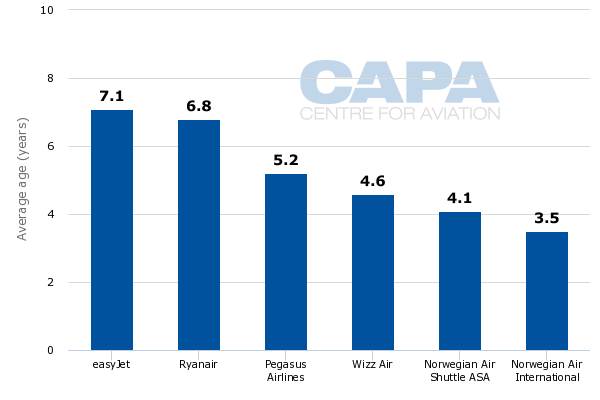
Fleet to grow at CAGR of 11% pa to FY2024; average size to increase, with more A321s and A321neos
According to the CAPA Fleet Database, Wizz Air has 139 aircraft on order as at 16-Jan-2017. Of these, nine are for A320s, 20 are for A321ceos and 110 are for A321neos. The first A321neos are due to enter the fleet from FY2019.
These orders are due for delivery by the end of FY2024, when the fleet total is set to reach 154 aircraft, with a mix of A320ceos, A321ceos and A321neos. In FY2017 (year to March) the fleet total is set to increase by 18%, the same rate that is planned for FY2018. However, the compound average rate from the end of FY2106 to FY2024 is planned to slow to 11% pa, although this is still a double digit rate.
Wizz Air's fleet plan involves an increase in the average aircraft size, driven by the A321 and A321neo, and an increase in the number of aircraft with winglets (which help to reduce fuel burn). The average number of seats per aircraft will grow by 27%, from 180 in FY2015 to 190 at the end of FY2017, and to 229 by the end of FY2024. The proportion of winglet equipped aircraft will rise from 36% to 100% over the same period.
Wizz Air: fleet plan to FY2024*
Fleet plan aims to lower unit cost
Wizz Air's fleet plan - with an increase in average aircraft size, the inclusion of newer generation engine technology and the use of winglets - is aimed at lowering its unit costs as it strives to remain cost competitive against its leading competitor Ryanair.
The two ultra LCCs are Europe's two lowest cost airlines and the continent's most profitable airlines by operating margin.
See related report: Ryanair, easyJet, Norwegian, Wizz Air, Pegasus Airlines: Europe's top LCCs' collective margin drops
In summer 2016 Wizz Air faced Ryanair competition on 14% of its city pairs, covering 30% of its seats. Moreover, Ryanair is expanding rapidly in Wizz Air's core region and has opened five new bases this winter, increasing this overlap to broadly one third of Wizz Air's capacity.
See related report: Wizz Air: city pair overlap with Ryanair on one third of seats. Opportunities for both; CASK crucial
2017 set to be another year of double digit passenger growth
Following Wizz Air's 19% increase in passenger numbers in 2016, its growth looks set to continue at a double digit rate in 2017. CAPA analysis of OAG data for winter 2016/2017 indicates planned seat growth by Wizz Air of almost 19% - a rate that is second only to Flybe among the top European airline groups.
See related report: European airline seat capacity growth accelerates - perhaps too quickly: Outlook for winter 2016/17
For summer 2017, current OAG data for the final week of Jun-2017 indicate a similar rate of seat growth, at 17% year-on-year.
Summer 2017: fleet up by 10, to 83 aircraft; number of bases up by 3, to 27
By the time of its 1H2017 results presentation in Nov-2016 Wizz Air was planning a fleet of 83 aircraft in summer 2017, an increase of 10 from summer 2016. These aircraft would be operating out of 26 bases in 14 countries, with Chisinau in Moldova and Kutaisi in Georgia adding to Wizz Air's 24 bases in 12 countries in summer 2016.
The chart below shows the summer 2017 aircraft numbers by base country that Wizz Air planned in Nov-2017.
Since then Wizz Air has announced (14-Dec-2016) a 27th base at Varna in Bulgaria, to open in summer 2017 with five new routes. This will increase the number of Wizz Air aircraft based in Bulgaria to eight, including seven in Sofia and one in Varna. It also plans an additional aircraft at Cluj, taking the total at the Romanian city to six, and a second at Kiev, taking the total at Ukraine's capital to two (reducing the number of aircraft in the chart below that were yet to be allocated from three to zero).
Wizz Air: number of aircraft based in each country, summer 2017 vs summer 2016
89 new routes (a 17% increase) announced for summer 2017
Wizz Air's 1H2017 results presentation in Nov-2016 listed 70 new routes that had been announced in the first half of its FY2017, mainly for launch in summer 2017, with some launched in the current winter schedule. These routes are listed in the chart below.
In Central/Eastern Europe, the most frequent countries of origin for these new routes are Poland and Romania, with 17 each, followed by Bosnia-Herzegovina and Hungary, with eight each, Serbia with seven and Bulgaria with five.
By country of destination in Western Europe: Germany leads with seven, followed by Spain and Italy with six each, the UK with four, and France and Portugal with three each.
Since then Wizz Air has announced 19 additional new routes that will be in operation in summer 2017, bringing the total number of new routes announced to 89. This is an increase of 17% from the 519 routes operated by Wizz Air during 2016 - a growth rate that is consistent with the seat growth data available from OAG and noted above.
The additional new routes announced after the 1H2017 results presentation include five routes from the new base at Varna from Jul-2017, to Dortmund, Eindhoven, Larnaca, Milan Bergamo and Memmingen.
The additional new routes also include five from Budapest for this summer, to Pristina, Podgorica, Sarajevo, Skopje and Tirana, none of which have been operated since the collapse of Malev in 2012.
There are also a further nine additional new routes from other Wizz Air bases: Cluj-Malta, Varna-Tel Aviv, Osijek-Basel, Cluj-Bratislava, Warsaw-Bratislava, Kiev Zhuliany-Copenhagen, Kiev Zhuliany-Nuremburg, Debrecen-Tel Aviv and Bucharest-Hannover.
Wizz Air: number of new routes by country, summer 2017
Wizz should be better positioned than most for any downturn
Wizz Air's passenger growth has been impressive, particularly since its 2014 IPO. Moreover, it has maintained a high growth rate while also improving its profit and margins. Its FY2017 net profit guidance of EUR245 million to EUR255 million implies growth of 12% at the midpoint. In the first nine months of calendar 2016 its operating margin of 20.9% was second only to Ryanair's 26.9%, among European airlines.
Meanwhile, the European airline profit cycle is showing signs of having reached a peak, with the beginning of a downswing possibly coming into view.
See related report: Air France-KLM, Lufthansa & IAG: 3Q2016 results may signal a cyclical peak in Europe airline margins
However, Wizz Air's high margins and strong cost focus, together with its clearly defined regional specialisation, should position it to weather any downturn better than most.
